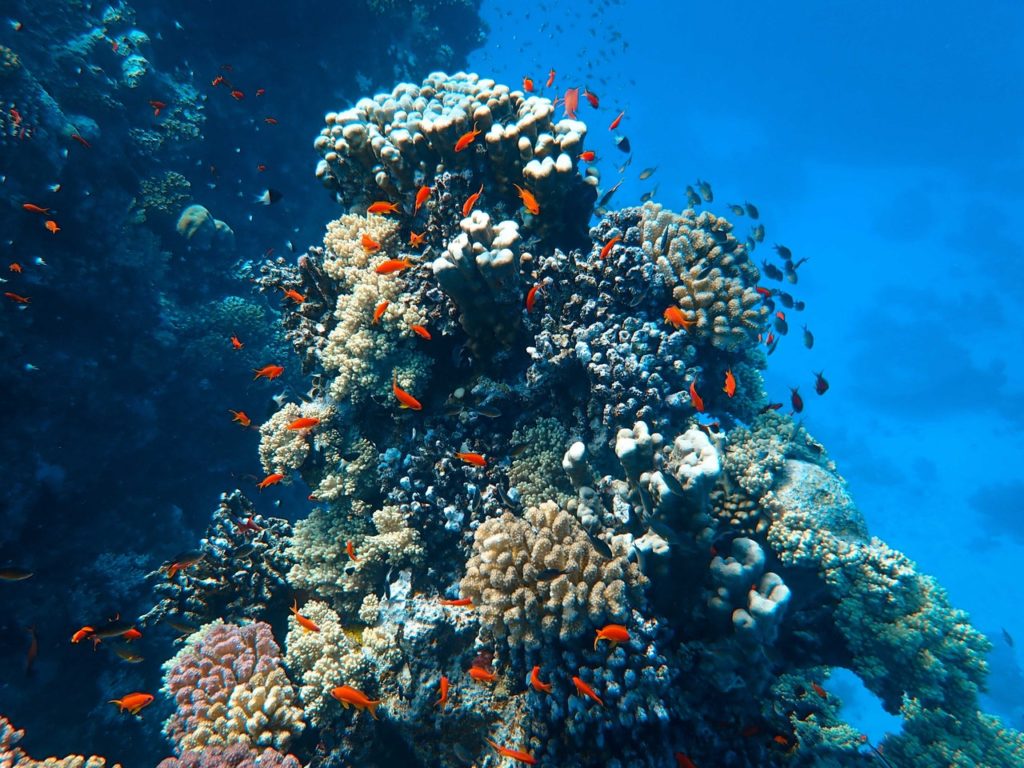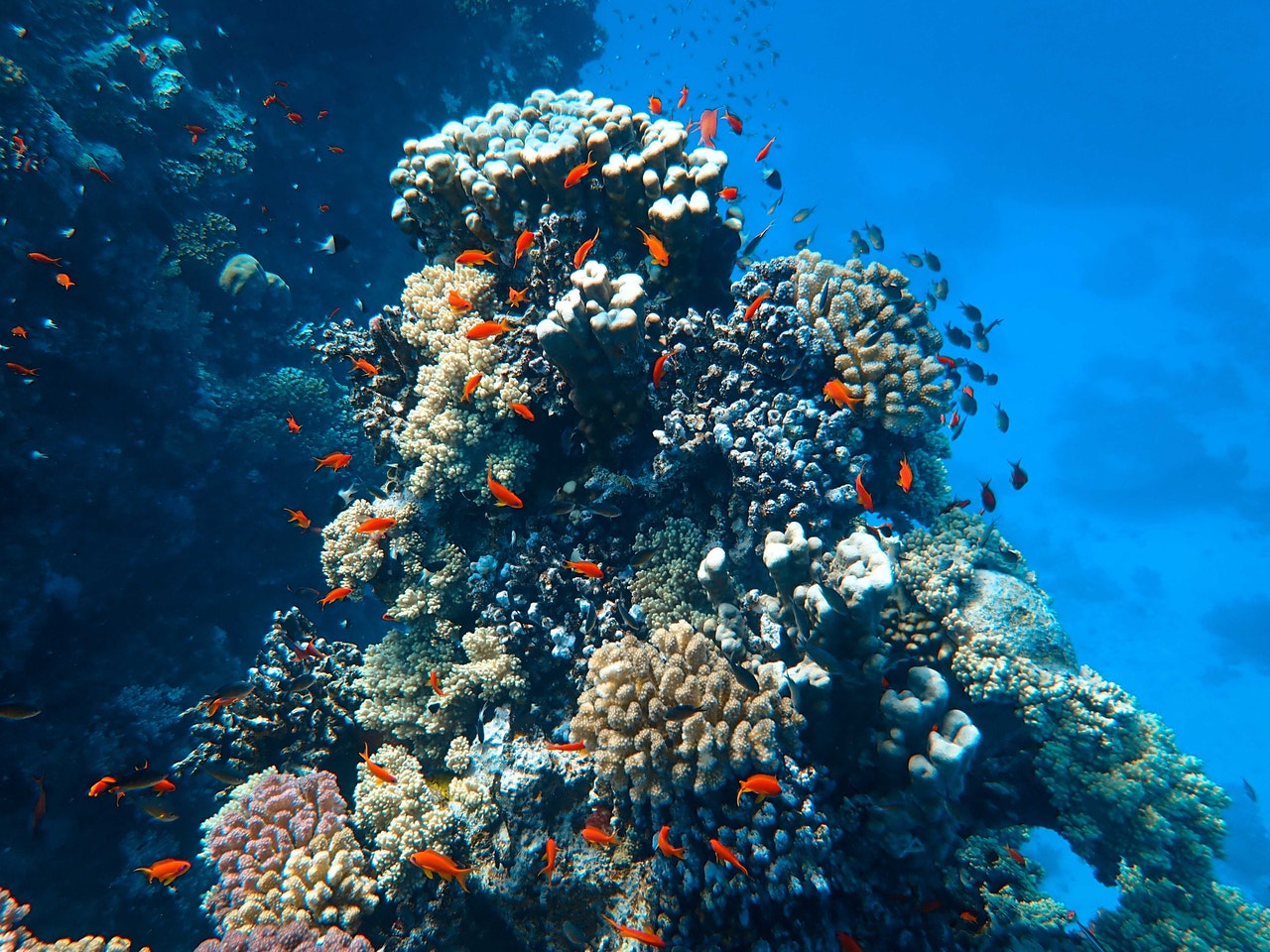
I learned this today. Corals are animals because they don’t produce their own food.
Corals are sometimes thought to be rocks and sometimes thought to be plants, but they are neither. They are animals. They are thousands of tiny animals collected together. Because of this, they are known as colonial organisms. They belong to the same species as jellyfish.
There are six thousand different species of coral around the world. They can generally be divided into soft corals and stony corals.
All corals are sessile. That means they are unable to move themselves. Plants are sessile. Mussels and many shellfish are sessile. Mussels can move using sea or river currents, but they usually don’t move. Sessile animals tend to clump together to aid reproduction and to protect themselves from predators. This is why corals clump together.
A coral colony is made of small individual creatures called polyps and can be made up of millions of polyps. Each polyp looks like a sac and is attached at one end to a hard surface. At the other end is a mouth surrounded by tentacles that the polyp can extend. These tentacles contain stinging cells to catch food. They usually eat plankton and fish larvae. After they eat, they release the waste products back out through their mouths.
Stony corals form because the polyps use ions from sea water to secrete a mineral called calcium carbonate, otherwise known as limestone. When a new polyp is born, it forms a cup and slowly builds an exoskeleton out of limestone. One end of the polyp attaches to the exoskeleton of other polyps, and it continues to grow the coral. The first polyps attach to rocks on the sea floor. The earlier polyps will die, but the coral will continue to grow. A coral can grow at a rate of about 10cm a year. The polyps leave small gaps in the exoskeleton so that they can release their tentacles and catch food. The polyps are connected by a system of canals, so that they can share nutrients.
Soft polyps are also a colony, but they don’t produce an exoskeleton. They are connected by mesoglea tissue, which is the same material jellyfish are made of. It is mostly water with fibrous proteins and collagen. There are also thousands of tiny channels in the tissue which allow the polyps to share nutrients throughout the colony.
Rocky coral use their calcium exoskeleton as protection against predators. Soft coral don’t have such protection. They secrete terpenoid, a toxin, into the sea to keep predators away.
Rocky corals have a symbiotic relationship with an algae called zooxanthellae. Algae is a plant, and it photosynthesizes. The algae and the coral have a good relationship and they both get benefits out of it. The algae lies on the coral’s exoskeleton and is protected from other predators. It gets to be in an elevated position which is closer to sunlight. It gets nutrients, waste products, and carbon dioxide from the polyps. In return, the algae supply the polyps with oxygen and carbohydrates that they need to grow. The algae provides up to 90% of the energy that the coral needs.
Coral are usually beautiful colors, but this color comes from the polyps themselves. The calcium exoskeleton that they make is white. The zooxanthellae that live on them give the coral a green-brown base color. On top of that, different polyps have developed different proteins that reflect specific wavelengths of light, giving them their fabulous colors. They do this to protect the algae that live on them and to absorb more of the light that the algae can use for photosynthesis.
Recently, climate change is causing coral bleaching on a massive scale. When the water heats up, the coral expel the algae that lives on them. This exposes the white color of the exoskeleton and is called coral bleaching. Once the algae has gone, the coral usually dies because it cannot produce enough food on its own. On top of this, the increasing amount of carbon dioxide that is being absorbed into the sea inhibits the polyps’ ability to make the exoskeleton that they need to survive. Estimates say that almost all of the Great Barrier Reef has been bleached as of 2021, and the production of new coral has dropped by as much as 71%. The Australian government is trying to come up with measures to reverse this trend, but it is a global issue and not just an issue for one country. And this is what I learned today.
Photo by Francesco Ungaro from Pexels
Sources:
https://www.unep.org/news-and-stories/story/why-are-coral-reefs-dying
https://floridakeys.noaa.gov/corals/coralanimals.html
https://en.wikipedia.org/wiki/Coral
https://en.wikipedia.org/wiki/Terpenoid
https://en.wikipedia.org/wiki/Scleractinia
https://en.wikipedia.org/wiki/Octocorallia
https://en.wikipedia.org/wiki/Mesoglea
https://en.wikipedia.org/wiki/Zooxanthellae
https://en.wikipedia.org/wiki/Sessility_(motility)
https://oceanservice.noaa.gov/facts/coral.html
https://www.nationalgeographic.org/encyclopedia/coral/
https://www.livescience.com/40276-coral-reefs.html
https://www.icriforum.org/about-coral-reefs/what-are-corals/
https://www.biologicaldiversity.org/campaigns/freshwater_mussels/natural_history.html
https://faq-all.com/en/Q%26A/page=74ec735466fb3368c69f8f6e8a5b5857
https://sciencing.com/coral-reefs-come-many-colors-5434662.html
https://www.aims.gov.au/docs/research/climate-change/coral-bleaching/coral-bleaching.html

